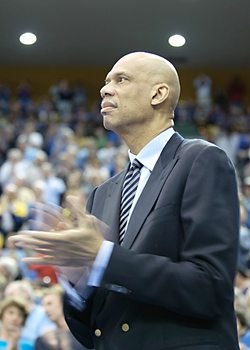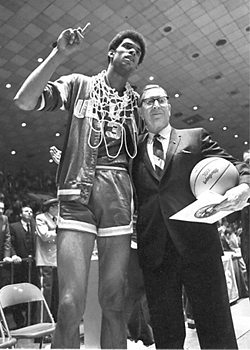By Ryan Eshoff – Daily Bruin – March 30, 2010 at 9:14 a.m.
The year is 1967, and the most exciting play in sports has been relegated to the bench. Thanks to one man’s particular dominance, the slam dunk in college basketball has gone the way of the spitball and the steroid – banned from competition. But what was meant to slow Kareem Abdul-Jabbar only accelerated his supremacy. Turning obstacles into opportunities? That may as well have been the title of his life story.
In his three years at UCLA – freshmen were not allowed to play varsity basketball at the time – the man still known as Lew Alcindor took ownership of the Final Four, and of college basketball in general, in a fashion that makes Donald Trump look like a timid peasant. Playing under legendary coach John Wooden, Abdul-Jabbar’s Bruins won national titles in 1967, ’68 and ’69, with the 7-footer from Manhattan taking home the Final Four Most Outstanding Player award all three times, a feat that has never been duplicated.
The NCAA caught on to his superiority quickly and banned the dunk after the ’67 season, not that that had the desired result.
“It really didn’t affect my game that much,†Abdul-Jabbar said. “I think really the fans suffered more than any individual player. The dunk is a play that pleases the fans and they didn’t get to see that for a while.â€
The king of the Final Four adapted to the statute with ease, embracing a more finesse style of play that included his signature “skyhook†shot. Abdul-Jabbar and his teammates recognized that what was intended to be an impediment was instead an inspiration.
“The skyhook was the most unstoppable shot; I don’t think he ever missed in practice,†said Lynn Shackelford, who played with Abdul-Jabbar at UCLA for all three seasons. “In the world of unintended consequences, (the banning of the dunk) made him a better player.â€
 In a career laced with superlatives, triumphs and records, Abdul-Jabbar imprinted himself permanently on the college basketball spectrum. The knack for winning – check that, dominating – dates back to his high school days, when his teams won three New York City championships and lost just twice in three seasons. For Abdul-Jabbar, conquering the Final Four served as the culmination of childhood visions.
In a career laced with superlatives, triumphs and records, Abdul-Jabbar imprinted himself permanently on the college basketball spectrum. The knack for winning – check that, dominating – dates back to his high school days, when his teams won three New York City championships and lost just twice in three seasons. For Abdul-Jabbar, conquering the Final Four served as the culmination of childhood visions.
“Just having the opportunity to do something that I had dreamed of doing when I was in high school,†he said of the excitement of being a collegiate champion. “As you play high school basketball and start to approach your college years, you dream about getting to the NCAA finals and winning it.â€
As he proceeded to usurp the college game and establish new standards, Abdul-Jabbar was moving into uncharted territory. Many of those involved in the college basketball world were unfamiliar with how to deal with his stature and skill.
“He had guys in the stands making fun of the way he played,†Shackelford said. “Referees had no idea what he was dealing with, but he moved on, excelled. Kareem faces things in a very analytical and non-emotional way. He’s going to analyze it, accept it, fight it. That’s the way he was on the basketball court.â€
The accolades and accomplishments didn’t end with a UCLA diploma; Abdul-Jabbar’s NBA career saw him set the all-time scoring record, win six championships and take home six MVP awards. That isn’t to say that even the professional ranks didn’t provide their fair share of adversity for the lanky center; game after game of toiling under the basket with thicker opponents took its toll on Abdul-Jabbar physically. Eventually, he contracted corneal erosion syndrome, which forced him to don his trademark goggles. The eye problems, which dated back to his UCLA days, did little to derail Abdul-Jabbar’s Hall-of-Fame career. In hindsight – perhaps without the burden of the goggles – it was just another obstacle that had to be overcome for greatness to be achieved.
“I just see myself as being in a position of having to accept what comes my way,†Abdul-Jabbar said. “You have to have an attitude where you accept what comes your way and deal with it in the most positive terms that you can.â€
If the curveball – that baseball phenomenon so often used to signify life’s adverse situations – has a basketball equivalent, it’s the skyhook: a change-of-pace, high-arcing floater that is nearly impossible to defend against when executed properly. This is perhaps the definitive image of Abdul-Jabbar’s career: a lofty reign highlighted by a signature shot on one hand, and a life spent dealing with curveballs on the other.
Late in 2008, the long-retired star was diagnosed with chronic myeloid leukemia, a rare cancer of the blood and bone marrow. A year later, the traditionally private Abdul-Jabbar went public with his condition, which can be managed and treated to a significant extent thanks to modern medicine.
“I think that I have the opportunity to get a few messages across,†Abdul-Jabbar said of being such a prominent figure who has the disease. “(Like) the whole idea of understanding that early diagnosis and treatment really enable us to survive situations like that.â€
Those on the front line of the battle are appreciative of the basketball legend’s openness concerning his disease, especially considering this particular player’s penchant for battling through adversity. Dr. Gary Schiller, a physician and researcher in UCLA’s Division of Hematology and Oncology, stressed the importance of a well-known public figure becoming a voice to the community.
“It’s good for patients who have the disease,†Schiller said. “It brings awareness to cancer and cancer research. It also brings to light one of the successes in that there’s a very well-designed, therapeutic procedure that’s a result of quality research.â€
Although his tendency had been to avoid the spotlight, Abdul-Jabbar’s post-basketball career was of the Renaissance-man variety. In fact, the basketball legend expressed hope that his name will be remembered not just for the on-court numbers, but also for his accomplishments as an author and someone who is involved in a number of social issues.
The most iconic element of his off-court career might just be an appearance in the comedy film Airplane!, in which his character Roger Murdock is famously addressed with the line “Roger, Roger.â€
“I don’t think that will ever be completely behind me,†chuckled Abdul-Jabbar while reminiscing about his film career. “Everybody in the airline profession watches that movie, and so far, nobody seems to have forgotten it.â€
The character of Roger Murdock isn’t the only aspect of Abdul-Jabbar that warrants remembering. His teammates, for instance, still recall the player, the man who transcended college basketball, dominated the Final Four, and who faced life’s obstacles with the grace of a skyhook.
“Talk about a guy in phenomenal health and condition,†Shackelford said. “A model of health and consistency: that’s the way I and other teammates remember him by. Being solid as a rock.â€

